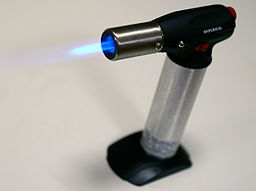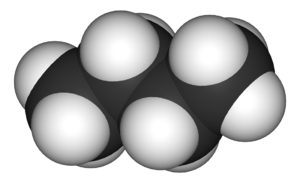Butane: Difference between revisions
J.williams (talk | contribs) No edit summary |
J.williams (talk | contribs) m (1 revision imported) |
(No difference)
| |
Revision as of 21:30, 26 August 2015

Figure 1. A butane torch for kitchen use (specifically for crème brûlée).[1]
Butane is a hydrocarbon that can be burned as a fuel. It's chemical formula is C4H10. It is often one of the components of natural gas.[2] Butane is commonly mixed with propane in camping fuel in order to maintain higher pressures at low temperatures.[1] Butane is also one of the key ingredients in lighter fluid and is commonly used in cigarette lighters, portable stoves and butane torches (see figure 1).
Like all hydrocarbons, butane undergoes hydrocarbon combustion when used as fuel.
Properties
Below is a table of some of the basic properties of butane.
| Formula | C4H10 |
| Molar mass | 58.12 grams/mole |
| Energy density | 49.5 MJ/kg[4] |
| Melting Point | -138oC[5] |
| Boiling Point | -0.5oC[5] |
Combustion Animation
Butane is used as a combustible fuel. Below is an animation showing the net reaction that occurs during the hydrocarbon combustion of butane.
References
- ↑ 1.0 1.1 [CC BY-SA 3.0 (http://creativecommons.org/licenses/by-sa/3.0) or GFDL (http://www.gnu.org/copyleft/fdl.html)], via Wikimedia Commons accessed 1/29/2015. Cite error: Invalid
<ref>tag; name "book1" defined multiple times with different content - ↑ Center for Energy Economics. (2015). Composition of Natural Gas and LNG [Online]. Available: http://www.beg.utexas.edu/energyecon/lng/LNG_introduction_07.php [February 16, 2015].
- ↑ "Butane-3D-space-filling". Licensed under Public Domain via Wikimedia Commons - http://commons.wikimedia.org/wiki/File:Butane-3D-space-filling.png#mediaviewer/File:Butane-3D-space-filling.png
- ↑ Glenn Elert. (2015). The Physics Hypertextbook - Chemical Potential Energy [Online]. Available: http://physics.info/energy-chemical/ [February 16, 2015].
- ↑ 5.0 5.1 Charles E. Ophardt. (2003). Virtual Chembook - Hydrocarbon Boiling Points [Online]. Available: http://www.elmhurst.edu/~chm/vchembook/501hcboilingpts.html [February 16,2015].


